#aquatic ecology
Text

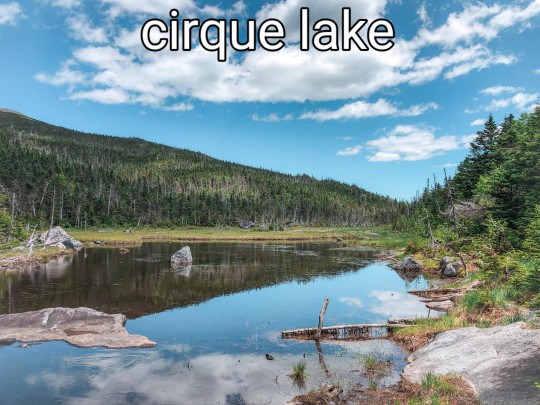
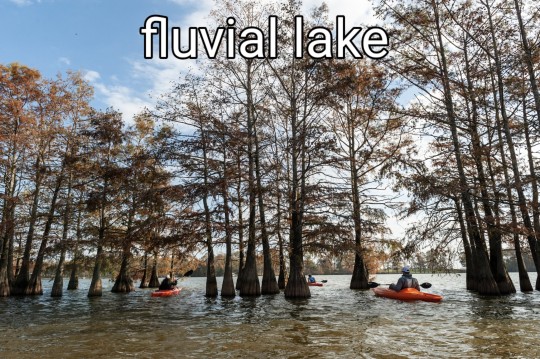







#lakes#lakeposting#poll#geology#geomorphology#nature#lake#naturecore#beautiful#limnology#science#ecology#aquatic ecology#water#meteor#meteorite#volcanic#glacier#glacial#tectonic#earth#environment#environmental science
2K notes
·
View notes
Text
I attended my first in-person conference on Tuesday, the British Ecological Society Aquatic Group annual meeting at Lancaster University! It was quite a small conference, but really enjoyable! So many incredibly interesting talks, ranging from global warming and ocean acidification to using meeting sponges to assess community diversity through eDNA!
Despite the grey, drizzly weather, it was a great experience, and I definitely have a few more papers to read and connections to make!
Lancaster uni also had a lovely campus with pretty architecture and lots of little green spaces! There was a gorgeous coffee shop on campus (who do amazing vegan hot chocolate!) called Coastal and co. If you're ever on campus, I highly recommend them! :)
Please enjoy this little photo I took outside of where the conference was! You can just about see the coffee shop I mentioned in the back!

#phd life#marine ecology#ecological modelling#marine biology#ecology and conservation#marine ecosystems#phd research#phdblr#phd#academic conferences#British Ecological Society#aquatic ecology#aquaculture#university journey#uk universities#lancaster#Lancaster University#building confidence#working with social anxiety
5 notes
·
View notes
Text




highlights from today's aquatic eco lab :-)
images as follows: the stream we took samples from, ripple-like patterns in the rock, a pale feather, and a gif of a minnow school
#txt#aquatic ecology#college stuff#we found a shit ton of planaria which was neat bc i'd previously only heard about them in aquariums :0#and there were so many minnows!! probably hundreds.. <3#♡
7 notes
·
View notes
Photo

This boy holds suckermouth catfish caught in the Turag River in Dhaka's Mirpur Beribadh area on Wednesday (14 December 2022). Native to South America, the fish has invaded inland waters, including all major rivers, thus posing a threat to the local aquatic ecology and freshwater fisheries — FE photo by KAZ Sumon
#suckermouth catfish#turag#dhaka#mirpur beribadh#south america#aquatic ecology#fe photo#kaz sumon#financial express#bangladesh
0 notes
Text
There's been a recent increase in the removal of old dams and other barriers on salmon streams on the west coast of the U.S. While last year's removal of part a weir from McKay Creek wasn't as dramatic as the removal of dams on the Klamath River, the results of the removal are very promising.
The weir was installed about thirty years ago due to the creek being drained by a nearby reservoir. Unfortunately, its design meant that salmon could no longer go higher up the creek to their historic breeding grounds.
The power of nature's resiliency--if we give it the chance to recover--was evident in the fact that this past February saw the return of the salmon to the creek for the first time in three decades. What's even more exciting is that scientists found not just a few redds (salmon egg nests), but seventy-two of them in a six mile stretch of the creek above the weir! That's incredibly impressive, considering how long salmon were blocked from that area.
Here's to more projects like these giving our salmon a fighting chance for survival in spite of everything we've thrown at them over the years.
#salmon#fish#fishblr#icthyology#aquatic ecosystems#dams#dam removal#conservation#environment#environmentalism#habitat restoration#endangered species#extinction#wildlife#animals#nature#ecology\#restoration ecology
569 notes
·
View notes
Text
It's big, it's strong, its scaly, it's this week's Wet Beast Wednesday topic! An arapaima, also known as a pirarucu or paiche, is any of four species of fish in the genus Arapaima in the order of bony-tongued fish. There is som ongoing debate about the classification of the species, so to keep thing simple, I'm going to use the most common species names of Arapaima gigas (the type species and most well known, and the one with the most confusion about its classification), Arapaima agassizii, Arapaima leptosoma, and Arapaima mapae. Because A. gigas is the most well-studied of the species, unless I say otherwise you can assume everything I say in this post applies to it.

(image: an arapaima)
Arapaimas are bony fish that retain several primitive traits, causing them to sometimes be identified as "living fossils". They are most notable for their size, with A. gigas being a contender for the largest freshwater fish in the world. The maximum recorded size for one was 3.7 meters (10 ft) and 200 kg (400 lbs), but most get to around 2 meters (6.6 ft) long and 200 kg (440 lbs). That average length is decreasing as overfishing of the largest individuals is resulting in a selective pressure for smaller sizes. In addition to their size, they are extremely strong and can move fast if needed. Arapaima are fully capable of leaping out of the water if disturbed or they feel their current pond in unsuitable. Because of their strength, specimens in captivity must be handled with care as they can easy break bones if they slap someone. They live in rivers and lakes in South America, where they are often the top predators.
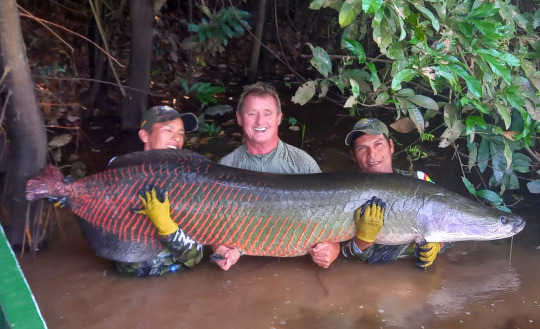
(image: several anglers with an arapaima)
Arapaimas are obligate air-breathers and will drown if they can't get to the surface to breathe. This is accomplished with a specialized swim bladder. The swim bladder is filled with highly vascularized tissue, letting it act like a lung. This pseudo-lung opens into the mouth using a modified gill arch known as the labyrinth organ. Arapaima gills are too small to sustain them, but they can supplement their oxygen intake with the gills. Juveniles are born exclusively using their gills and transition into air-breathers shortly after hatching. Arapaimas can survive up to a full day out of the water. They typically surface to gulp in air every 15-20 minutes. Breathing makes a loud gulping sound that anglers use to target them.
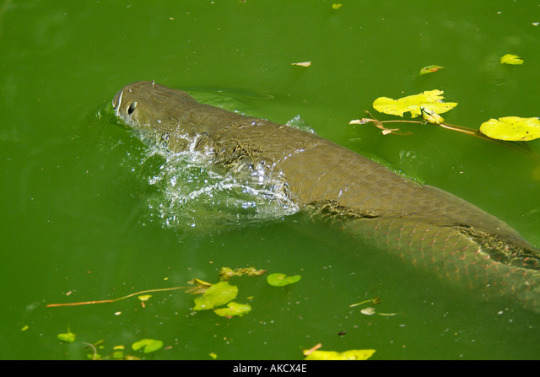
(image: an arapaima at the surface)
Because of their ability to breathe air, arapaimas are top predators in low-oxygen environments. Non-air breathing fish are forced to slow down in water with low levels of dissolved oxygen as they can't get enough oxygen through their gills. Since Arapaimas breathe air, they can easily chase down lethargic smaller fish. They are especially potent predators during the low season, when water levels lower. A combination of rotting vegetation reducing oxygen levels and ponds getting cut off from rivers and losing a supply of oxygen lets the arapaima reign supreme. Arapaimas are primarily predators that feed on smaller fish, though they will hunt other types of animals and eat fruits and seeds. Even land animals aren't safe as arapaimas have been known to launch themselves out of the water to catch animals near the shore. A combination of sharp teeth and their bony tongues are used to debilitate prey.
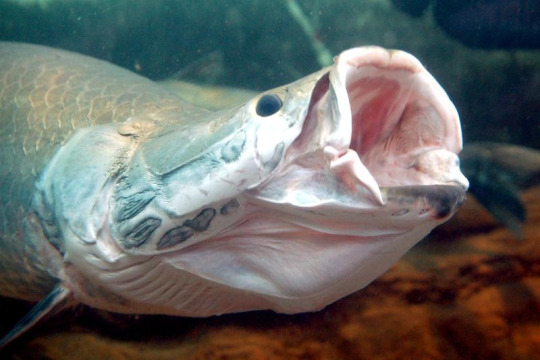
(image: an arapaima with its mouth open)
Not content with powerleveling their attack stat, arapaimas also have excellent defense. Their scales have been compared to bullet proof vests. Each has a hard, mineralized outer layer over multiple layers of collagen fibers. These layers are all oriented at an angle to each other to provide extra strength. This orientation of layers is called a Bouligand-type arrangement and is similar to how plywood is assembled. The harder outer layers and flexible inner layers work together to allow for both strength and flexibility. These scales help provide protection form large predators such as caiman and small threats like biting piranha. They also like provide protection from other arapaima, as the fish are aggressive and will fight each other.

(image: a diagram showing the composition of arapaima scales. source)
You probably wouldn't expect a swimming tank of an animal to be a good parent, but you'd be wrong. Arapaimas work together in mated pairs to build nests for their eggs, then cooperate to guard the nest. Once the eggs hatch, the male will practice mouth brooding, keeping his young safe in his mouth. The female will also help by patrolling the area around the male to ward off predators. They secrete pheromones from their heads to ensure the young don't swim too far away. Eggs are laid either in in the low season or as water levels are starting to rise, ensuring that the young become independent during the high season.
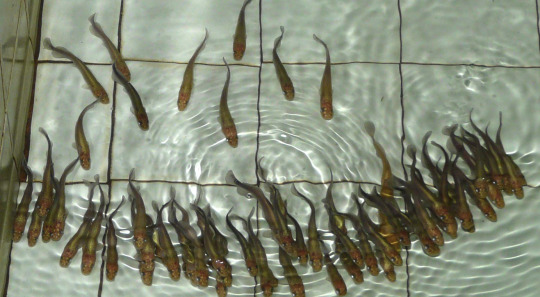
(Image: baby arapaimas)
Arapaima are classified as "data deficient" by the IUCN. This means there isn't enough data to properly assess their conservation needs. They are known to be threatened by overfishing. Arapaima make up a large part of the diet of many South American populations. Habitat loss and pollution are also believed to threaten them. They have been introduced to many areas out of their native range and are an invasive species in placed like Florida, Malaysia, and India.
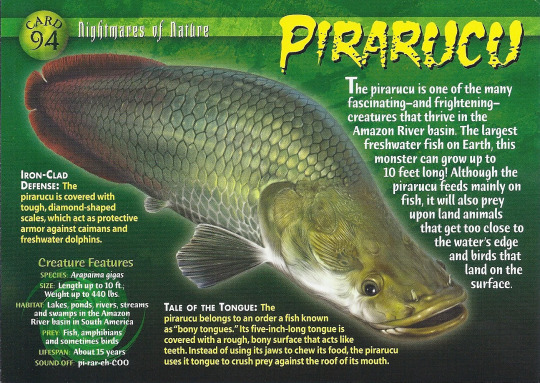
Does anyone else remember these cards? (image: the arapaima card from Weird n' Wild Creatures)
#wet beast wednesday#fishblr#fish#biology#zoology#ecology#animals#aquatic biology#animal facts#absolute unit#arapaima#pirarucu#paiche
1K notes
·
View notes
Photo

TYPES OF WETLANDS:
Did you know there are different kinds of wetlands? In addition to the tidal salt marshes you might think of, there are also swamps, bogs, fens, and freshwater marshes!
Types of wetlands:
Marshes
Marshes are defined as wetlands frequently or continually inundated with water, characterized by emergent soft-stemmed vegetation adapted to saturated soil conditions. There are tidal salt marshes or freshwater marshes.
Swamps
A swamp is any wetland dominated by woody plants.
Bogs
Bogs are characterized by spongy peat deposits, acidic waters and a floor covered by a thick carpet of sphagnum moss.
Fens
Fens are peat-forming wetlands that receive nutrients from sources other than precipitation: usually from upslope sources through drainage from surrounding mineral soils and from groundwater movement. Fens differ from bogs because they are less acidic and have higher nutrient levels.
Learn more about wetlands:
https://www.epa.gov/wetlands/classification-and-types-wetlands
2K notes
·
View notes
Text

Clownfish at Osaka Aquarium Kaiyukan
#fish#fishes#clownfish#aquatic animals#animals#marine biology#nature#wildlife#nature photography#photography#mine#ecology#naturalist#vertebrates#asia#japan#aquarium#zoo animals#zoo
558 notes
·
View notes
Text




earth fact time. devil's hole pupfish are the rarest fish on earth. they are also the most inbred fish on earth! they live in ONE place, a hole in the ground called devils hole in nevada. and the thing is they can only survive in that hole, which is 93Fº. literally no other fish can survive in those conditions.
because of their tiny environmental niche, they're critically endangered, so there's a program working to breed them. but the thing is that these guys evolved SO WELL that the conditions they live in have to be exactly like devils hole, or else they straight-up just die, so scientists have needed to replicate the devils hole environment for them to survive.
last year science hippies counted 263 fish, which is a 19-year high!
npr | national park foundation | national wildlife federation | phys.org
photos from usfws national digital library, taken by olin feuerbacher
#aquatic#earthposting#facts!#marine biology#biology#marine life#freshwater fish#marine animals#zoology#fishblr#fish#marine ecology#ichthyology#devils hole pupfish#earth fact no. 15
156 notes
·
View notes
Text
arapaima gigas
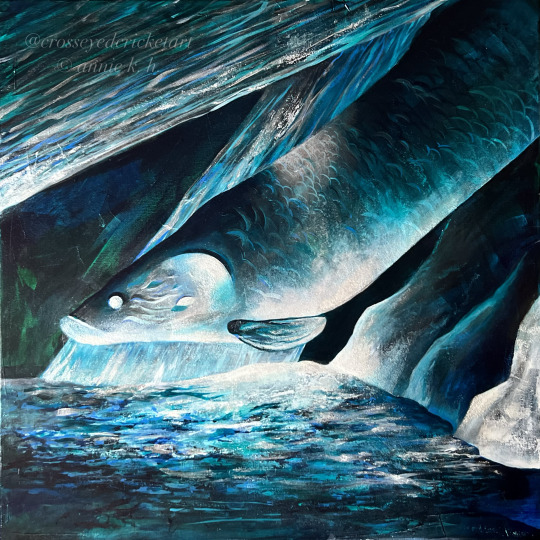
arapaima, river giant.
2023 / 24” x 24” / acrylic and glitter on canvas
arapaimas are some of the largest freshwater fish in the world. this is based off a photo I took in the Tennessee aquarium. this is a painting in inverse, meaning the white is shadow and the dark areas are light.
And with some horrible procreate skills, here’s what it “should look like” with the shadows being dark and the highlights being light:

i did my best don’t bully me I’m bad at digital editing
#art#painting#fish#fishblr#freshwater fish#Arapaima gigas#Arapaima#Freshwater#freshwater ecology#Fishes#fish art#aquatic life#Animals#marine animals#marine art#🖤 art tag
54 notes
·
View notes
Text

Wimple Piranha (Catoprion mento)
Family: Serrasalmid Family (Serrasalmidae)
IUCN Conservation Status: Least Concern
A tiny (15cm/5.9 inches in length) relative of the more famous Red-Bellied Piranha, the Wimple Piranha is found in the Amazon, Orinoco, Paraguay and Essequibo river basins, and is notable for its unusual diet; adults of this species feed almost exclusively on fish scales, feeding by ramming into larger fish at high speeds with their mouths wide open, biting and generating suction to dislodge their target’s scales and pull them into their mouths. The practice of eating scales, known as lepidophagy, is rare in animals as scales are difficult to digest and require considerable amounts of energy to obtain, and it is likely that it developed in response to the intense competition between fish species in the biodiverse rivers to which Wimple Piranhas are native - although their nutrients-poor diet limits their size, feeding exclusively on scales (occasionally supplemented by small insects or small amounts of the meat of their otherwise unharmed targets where possible) allows Wimple Piranhas to find food while largely avoiding competing with larger and less specialised carnivores. Besides their unusual feeding habits little is known about the biology of wild Wimple Piranhas, although through the observation of captive individuals it has been found that unlike many piranha species they are solitary (possibly avoiding living in groups to avoid competing with other members of their species,) and that like other members of their family females of this species lay eggs.
--------------------------------------------------------------------------
Image Source: https://www.inaturalist.org/taxa/342485-Catoprion-mento
#Wimple Piranha#piranha#piranhas#fish#fishes#zoology#biology#icthyology#animal#animals#wildlife#South American wildlife#freshwater fish#bony fishes#bony fish#aquatic wildlife#evolution#ecology
102 notes
·
View notes
Text
Zooplankton are tiny crustaceans that occupy a variety of roles in Great Lakes food webs, from open water filter feeding to benthic decomposers 🩵
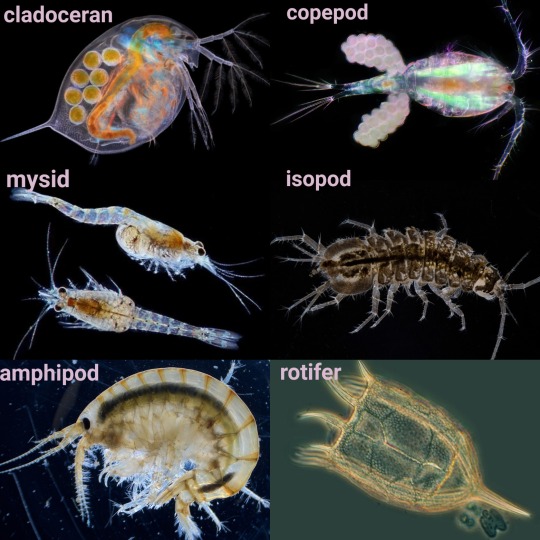
#great lakes#lakeposting#poll#lake#freshwater#freshwater ecology#aquatic ecology#ecology#biology#science#crustaceans#cute#animals#shrimp#freshwater science#limnology#aquatic#plankton#zooplankton#cladocerans#copepods#amphipods#isopods#rotifers#food web#nature#naturecore#microscopic#miniature
476 notes
·
View notes
Text
This is so cool! Finding animal life beneath hydrothermal vents is incredible! Some of the things they found in the underwater cave systems in earth's volcanic crust include snails and tube worms. These tube worms alongside chemosynthetic bacteria, use the hydrogen sulphide in the chemical plumes from thermal vents by oxidising it to create energy and sugars to survive. How cool is that?!
I think this article also really demonstrates how important it is to conserve and protect lesser known ecosystems and species.
#protect the weird and wonderful#protect the ocean#ocean conservation#marine benthos#marine ecosystems#marine biology#aquatic ecology#aquatic creatures#ecology and conservation#marine ecology#deep sea#deep sea mining#deep sea creatures#deep sea conservation#Ocean thermal vents#tube worms#chemosynthetic bacteria#chemosynthesis
4 notes
·
View notes
Text
I've applied to SERC 5 times now and still haven't even gotten an interview. I exceed the qualifications and I should have priority since I was trained by the Smithsonian. Are the other people applying super geniuses?? Literally its research technician positions and internships. I have over a year's experience as a field tech not including my academic experience. I'm tempted to email the lab manager and ask what training I need for her to hire me.
#wrenfea.exe#working while disabled#SERC is the place to be for aquatic invertebrates#freshwater and marine#maybe they want people with marine biology degrees??#i have an environmental sci degree but Ive taken a ton of marine science classes#hey if any of my followers work at SERC#pls...let me in..#marine biology#freshwater ecology#fishblr#invertebrates#marine science
41 notes
·
View notes
Text
drew some mussels :) eventually i’ll be making these bad boys into a minnesota native mussel sticker set because i love mussels SO much and i want to share my love of them. i also realized recently that most people know that zebra mussels are bad, but i think we need to remember why zebra mussels are bad, not just that they are.
remember to always clean, drain, and dry your equipment to prevent the spread of zebra mussels and keep our native mussels safe :)

85 notes
·
View notes
Text

Mangroves- The Lifeline of many aquatic creatures
#writerslife#biodiversity#women writers#writer things#articles#writerscommunity#photooftheday#blogger#my photos#photography#mangroves#mangroves hashtag#conservation#mangrove#ecology#endangered species#ecosystem#environment#aquatic#aquatic life#fish#science#the more you know#biology
3 notes
·
View notes